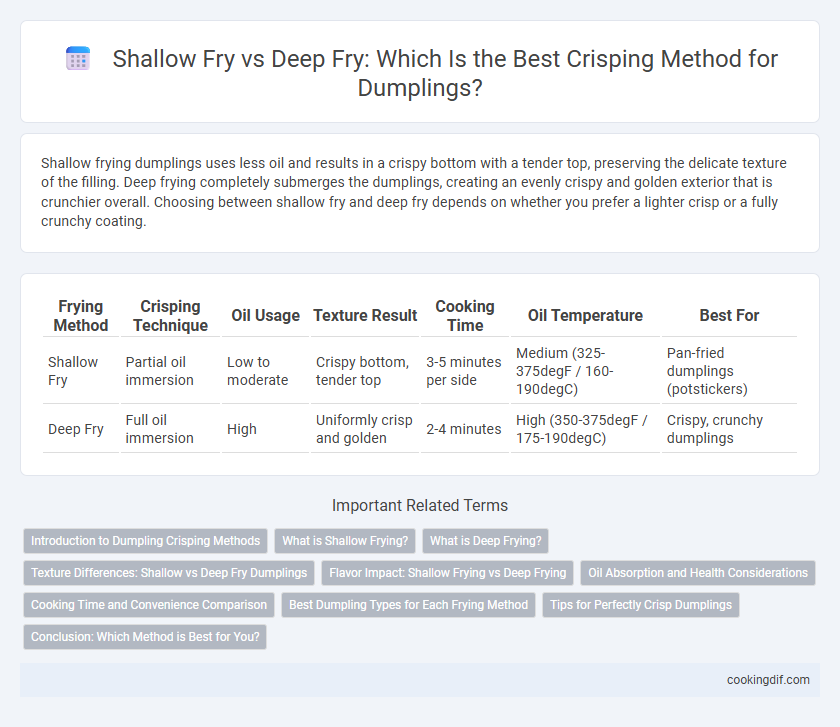Shallow frying dumplings uses less oil and results in a crispy bottom with a tender top, preserving the delicate texture of the filling. Deep frying completely submerges the dumplings, creating an evenly crispy and golden exterior that is crunchier overall. Choosing between shallow fry and deep fry depends on whether you prefer a lighter crisp or a fully crunchy coating.
Table of Comparison
| Frying Method | Crisping Technique | Oil Usage | Texture Result | Cooking Time | Oil Temperature | Best For |
|---|---|---|---|---|---|---|
| Shallow Fry | Partial oil immersion | Low to moderate | Crispy bottom, tender top | 3-5 minutes per side | Medium (325-375degF / 160-190degC) | Pan-fried dumplings (potstickers) |
| Deep Fry | Full oil immersion | High | Uniformly crisp and golden | 2-4 minutes | High (350-375degF / 175-190degC) | Crispy, crunchy dumplings |
Introduction to Dumpling Crisping Methods
Shallow frying dumplings involves cooking them in a small amount of oil, creating a crispy bottom while keeping the top tender and steamed, ideal for potstickers or gyoza. Deep frying submerges dumplings completely in hot oil, producing a uniformly golden, crunchy texture suitable for wontons or crispy appetizers. Both methods enhance the flavor and texture by crisping the outer layer, but shallow frying offers a balance of crisp and soft, whereas deep frying delivers maximum crunchiness.
What is Shallow Frying?
Shallow frying involves cooking dumplings in a small amount of hot oil, usually covering only half the dumpling's surface, which crisps the exterior while maintaining a tender interior. This method allows for better control over cooking temperature, reducing oil absorption and resulting in a lighter, less greasy texture compared to deep frying. Shallow frying is ideal for achieving a crunchy bottom crust and evenly cooked filling without submerging the dumplings completely in oil.
What is Deep Frying?
Deep frying involves submerging dumplings completely in hot oil, typically between 350degF to 375degF, ensuring an even, golden-brown, and crisp exterior. This method creates a crunchy texture by rapidly cooking the outer layer while sealing moisture inside, preserving the dumpling's juicy filling. Compared to shallow frying, deep frying delivers a more uniform crispness and faster cooking time due to the full immersion in hot oil.
Texture Differences: Shallow vs Deep Fry Dumplings
Shallow frying dumplings results in a crispy, golden-brown bottom with a tender, steamed top, offering a contrast in textures between crunchy and soft. Deep frying dumplings creates an evenly crispy and crunchy exterior, enveloping the filling in a uniform crunchiness. The choice between shallow and deep frying significantly affects the dumpling's mouthfeel, with shallow frying preserving a more varied texture and deep frying providing a consistent crispness.
Flavor Impact: Shallow Frying vs Deep Frying
Shallow frying dumplings allows for more controlled browning and a subtle caramelized flavor due to limited oil immersion, preserving the delicate dough texture. Deep frying fully submerges dumplings, creating an even, golden crust with a pronounced crispiness and richer, intensified flavor from Maillard reactions. The choice between shallow and deep frying significantly influences the flavor profile, with deep frying offering a bolder taste while shallow frying maintains a lighter, nuanced bite.
Oil Absorption and Health Considerations
Shallow frying dumplings results in lower oil absorption compared to deep frying, making it a healthier option with less fat content. Deep frying fully submerges dumplings in hot oil, increasing oil uptake and calorie count, which may raise health concerns related to high fat consumption. Choosing shallow frying can help retain a crispy texture while reducing excess oil intake and promoting better heart health.
Cooking Time and Convenience Comparison
Shallow frying dumplings typically takes 5-7 minutes and requires less oil, making it a quicker and more convenient method for small batches. Deep frying dumplings takes about 3-4 minutes but uses significantly more oil, offering a uniformly crispy texture ideal for larger quantities. Shallow frying allows easier control over browning with simple utensil use, whereas deep frying demands precise temperature management to avoid greasiness.
Best Dumpling Types for Each Frying Method
Shallow frying dumplings like potstickers or gyoza creates a crispy bottom while keeping the top tender, making it ideal for dumplings with thinner, delicate wrappers. Deep frying suits dumplings such as wontons or samosas with thicker or filled wrappers, producing an evenly crunchy texture all around. Choosing the frying method depends on the dumpling dough thickness and filling moisture, optimizing crispness and flavor balance.
Tips for Perfectly Crisp Dumplings
To achieve perfectly crisp dumplings, shallow frying requires using moderate heat and enough oil to cover the bottom of the pan, gently flipping dumplings to cook evenly without burning. Deep frying demands preheating oil to 350degF (175degC) for quick, uniform crisping while preventing sogginess. For both methods, patting dumplings dry and using a non-stick pan or well-seasoned wok enhances texture and prevents sticking.
Conclusion: Which Method is Best for You?
Shallow frying dumplings offers a balance between a crispy bottom and a tender, steamed top, making it ideal for those who prefer a slightly healthier option with less oil absorption. Deep frying creates an evenly golden, ultra-crispy texture but increases oil content and cooking time, suitable for those seeking maximum crunch and indulgence. Choose shallow fry for a lighter, quicker crisp or deep fry for a richer, consistently crispy dumpling experience.
Shallow fry vs Deep fry for crisping method Infographic

 cookingdif.com
cookingdif.com